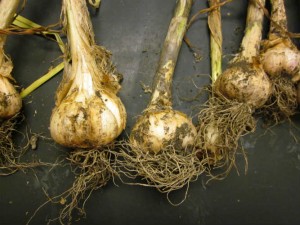What Is It? | Facts in Depth | For the Professional Diagnostician
Garlic & Onion Diseases | Garlic Bloat Nematode
Garlic Bloat Nematode
Symptoms
Bulbs
Bulbs initially are slightly discolored and as the disease progresses, the bulbs become very dark in color and begin to decay. Eventually, they get very soft and exhibit cracking. The basal plate also can be easily separated with slightly reduced roots.



Foliage
Above ground symptoms of bloat nematode infections include leaf splitting, stunting, curled or twisted leaves, stem softening/collapse and leaf swelling. Eventually, the plants exhibit pre-mature defoliation.
Signs
Ditylenchus dipsaci are vermiform in shape, up 1.5mm long, with a diagnostically conical and sharply pointed tail. They also have a short stylet with prominent knobs, a distinct median esophageal bulb, and a basal bulb slightly overlapping the intestine. The males have distinct bursa. More morphological differences are described in this pdf: These methods are described in detail in the pdf file Ditylenchus destructor and Ditylenchus dipsaci: https://gd.eppo.int/downfile/239_pm7-087-1-en.pdf.



Often Confused With
- Fusarium basal rot – Advanced infections of bloat nematode cause severe discoloration and rotting of the base of the bulb, which resembles symptoms of Fusarium basal rot. Fusarium basal rot is often a secondary infection to bloat nematode. Some differences between the two diseases are that Fusarium turns the bulbs pink and the roots are completely decayed, while the roots are usually intact with bloat nematode.
Extraction Methods
- Ditylenchus dipsaci can be extracted from plant tissue, soil and seeds. These methods are described in detail in the pdf file Ditylenchus destructor and Ditylenchus dipsaci: https://gd.eppo.int/downfile/239_pm7-087-1-en.pdf
- A simple method of extracting stem nematodes, Ditylenchus dipsaci Filipjev, from lucerne: http://onlinelibrary.wiley.com/doi/10.1111/j.1365-2494.1980.tb01506.x/abstract
Rapid Diagnostic Tests
- DNA was extracted from 50 to 100 nematodes using a PowerSoil DNA Isolation Kit (Mo-Bio Laboratories, Inc., Carlsbad, CA; http://www.mobio.com/soil-dna-isolation/powersoil-dna-isolation-kit.html) as well as from individual females, and partial ITS sequences were amplified using primer set TW81/AB28.
- Subbotin et al. Phytopathology 95:1308, 2005.
- http://apsjournals.apsnet.org/doi/pdfplus/10.1094/PHYTO-95-1308
- Expansion segments D2-D3 were sequenced following amplification of DNA from individual females using primer set D2A/D3B
- Tenente et al. Nematropica 34:1, 2004.
- http://journals.fcla.edu/nematropica/article/viewFile/69681/67341
